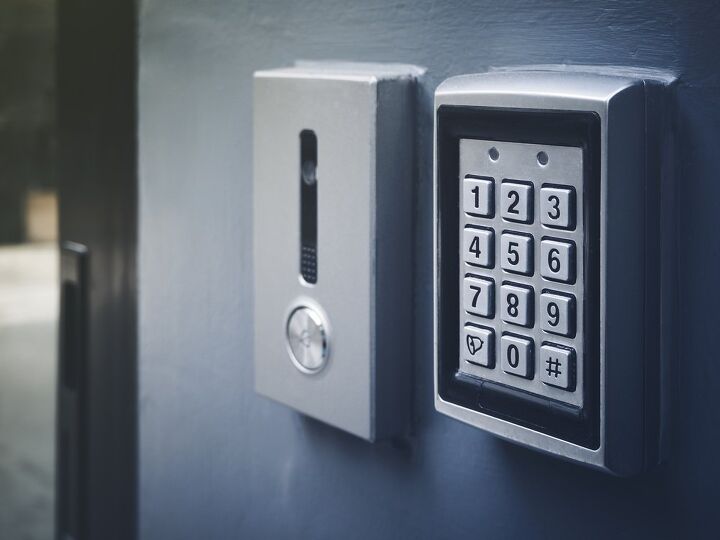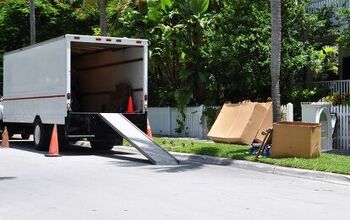How To Secure a Safe Without Bolting It To The Floor (Do This!)

A safe can be a great way to protect the truly valuable items in your home. Whatever those items are, having a safe to keep them protected can provide peace of mind in the event of a home break-in. Securing that safe so it can’t simply be removed is of the utmost importance.
When it comes to securing the safe, bolting it to the floor may not be an option. If you are looking for another method, try bolting the safe to a slab of steel. You can also add weight to it or hide it underneath some floorboards if you own the home.
Do You Need Handyman Services?
Get free, zero-commitment quotes from pro contractors near you.

Why Wouldn’t You Want to Bolt the Safe to the Floor?
Bolting the safe to the floor would make it more secure, right? So, why wouldn’t you want to imply bolt the safe to the floor? Well, there are two primary reasons that you wouldn’t want to do that. The first is that it damages the floor and the second is that you may not own the home.
- Damaging the floorboards. Bolting the safe to the floor may make it more secure, but it will do damage to the floorboards along the way. If you ever want to move the safe to another location, you will be left looking at damaged floorboards in its wake. You can choose to simply replace the floorboards, but that can be a hassle depending on your current flooring.
- Don’t own the home. Perhaps the biggest reason that someone would not want to bolt the safe to the floor is that they don’t own the home they live in. Sure, it may make sense to bolt the safe to the flooring, but the rental agreement may not allow for it. Make sure that you check out rental agreements before doing anything. Something like this could bring major fines with it from the landlord.
Method #1: Bolt the Safe to a Slab of Steel
One of the quickest and easiest options for securing the safe is to bolt it to a large piece of steel or a large pallet. Basically, this method adds a lot more weight to the safe, making it that much more difficult to move for potential thieves.
Even better, this is a fairly simple method. You will need a few supplies, a slab of steel, and you can secure the safe with little to no trouble.
Step 1: Gather Your Materials
Before you begin, you will need the proper materials. You will require a drill, a piece of steel about a quarter-inch thick, and the right sized screws. The steel has to be thick in order to make the safe substantially heavier.
It is also important to have a width large enough so that it won’t fit through a doorframe when attached to the safe. By choosing a big slab of steel, you are making any potential thieves work extra hard to extract the safe.
Step 2: Place and Mount
Now that you have your steel slab, place it where you want the safe to go. It is a good idea to keep the safe in a hidden spot; you never want to advertise that there is a safe anyway. The more hidden you can go, the better.
With the slab in place, put the safe on top. Because of the weight of the safe, you should be able to get it into a relatively stable position so that you can bolt it in the next step.
Step 3: Bolt
When you have positioned the slab and placed the safe on top, you are ready to bolt. Look around the base of the safe for bolt down holes. You will need to drill holes in the steel to prepare them for the bolts.
With the holes in place, you can bolt down the safe securely and easily. The size depends on the bolt holes in your safe; do a quick measurement beforehand to ensure that you have the right size. It will save you time and frustration in the end.
Method #2: Add Weight
If you don’t feel comfortable bolting the safe down to anything, let alone a huge slab of steel, there is another way. Add weight to the safe to make it as heavy as possible. When the safe is heavy enough, it can deter even the most determined of thieves.
Even better, this is easier and simpler than bolting the safe down anywhere. You can remove the weights and relocate the safe whenever you feel like it, providing greater flexibility and versatility where needed.
Step 1: Determine Your Location
Put the safe where you want it. Remember, pick a spot that is concealed so as to not bring it to the attention of visitors or potential burglars looking for a score. Even if the safe is very heavy, you don’t really want anyone to know about it.
It is also easiest to know where you want the safe before adding the weights. Moving it afterward may not be the most difficult thing in the world but it will take time and quite a bit of effort to move the safe after it has been loaded with weights.
Step 2: Find Heavy Objects
The best bet is to find weights if you have them laying around the house. Weights are pretty heavy and you can create a lot of extra weight without many of them. For simplicity’s sake, having weights is the easiest way to go.
That said, not everyone has weights in their home. You can always substitute random heavy objects from around your home for actual weights. Load up the safe with whatever you see fit to keep it weighed down.
Step 3: Load Up the Safe
The best way to do this is to have some kind of flat piece of plastic or metal. Lay the weights or other objects down on the bottom of the safe, making them as even as possible. With the weights placed, you can then lay down your plastic or metal.
The purpose of the plastic and metal is to provide a platform for your valuables to sit on. This makes the safe much heavier, too heavy for burglars, while allowing for easy and neat storage for your valuable objects.
Method #3: Hide it Under the Floorboards
Just because you may not want to drill into the floorboards doesn’t mean that you can’t make use of the floor. If weighing down the safe is not something you care to deal with, there is another method that just may work.
If your home has wooden floorboards, you can pull some of them up to hide the safe below. The only disadvantage here is that it won’t be easy to access the safe. So, if you need to get into the safe on a regular basis, this may not be the best method. Moreover, you run the risk of damaging the floorboards as well.
Step 1: Prop the Floorboards Up
There are a few different tools that can be used to pull up the floorboards. A prying tool is the best bet but you can use a grinder when necessary. With these tools, you can prop the floorboards up, giving you access to all of the space beneath.
Measure your safe to get a better idea of the kind of space that you need access to. This way, you can avoid pulling up any extra floorboards than is absolutely necessary. Just make sure to take your time and work with caution so as to not damage any of the floorboards.
Step 2: Check Out Your Space
Prying up the floorboards is meant to give you access to the space below. But there may not be as much space as you thought. The reason for this is that there may be piping or other mechanisms located underneath.
Try to find the location of piping or other mechanisms before pulling up floorboards. You may have to pull a few up to get a better idea before moving on to prying up the rest. This can also give you an indication of whether or not the area you have chosen is suitable for a safe.
Step 3: Put the Floorboards Back
Now that you have a proper storage space for your safe, you can lower it down into the floor gently. Do not just push the safe into the hole. It is a heavy piece of metal and will do a lot of damage this way. Lower it in carefully.
When the safe is secured beneath the flooring, you can then rearrange the floorboards back over top of it. Don’t worry about sealing the floorboards. You will undoubtedly need access to the safe at some point or another, so you wouldn’t want to seal them shut.
Do You Need Handyman Services?
Get free, zero-commitment quotes from pro contractors near you.

One Final Method
When all else fails, you can get an industrial glue that will secure the safe in place. All you need to do is use tracer tape around the base of the safe to provide protection for the flooring below. Then, add your glue and apply the safe to keep it secure from thieves and burglars.

Ryan Womeldorf has more than a decade of experience writing. He loves to blog about construction, plumbing, and other home topics. Ryan also loves hockey and a lifelong Buffalo sports fan.
More by Ryan Womeldorf










![The 10 Best Table Saws - [2022 Reviews & Buyer's Guide]](https://cdn-fastly.upgradedhome.com/media/2023/07/31/9070645/the-10-best-table-saws-2022-reviews-buyer-s-guide.jpg?size=350x220)




![How To Reset A Whirlpool Cabrio Washer [In 5 Easy Steps!]](https://cdn-fastly.upgradedhome.com/media/2023/07/31/9076531/how-to-reset-a-whirlpool-cabrio-washer-in-5-easy-steps.jpg?size=350x220)











